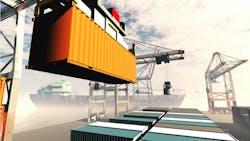Download this article in PDF format.
Multiple hurricanes, catastrophic flooding, an averted port strike and a severe shortage of intravenous (IV) fluids were just some of the major events that made supply chain headlines in October. With hurricanes Helene and Milton both inflicting damage in Florida and up the Eastern Seaboard, the weather’s wrath had both an immediate and longer-term impact on global supply chains.
At the University of South Florida (USF) in Tampa, Assistant Professor Seckin Ozkul is now analyzing the impacts of Hurricanes Milton and Helene in the university’s Supply Chain Innovation Lab. The team is creating models that reflect the effects of multiple large hurricanes hitting the same region in a short time span.
“The back-to-back impact of Hurricanes Helene and Milton presented new challenges, particularly with fuel shortages, which were exacerbated by the closure of Port Tampa Bay and the increased demand from evacuations,” Ozkul said in a university publication. “The goal is to support government agencies in making informed decisions to minimize disruptions and optimize evacuation plans during future storms.”
Ozkul hopes the models are ready before the 2025 hurricane season. That way, officials will be able to use them to help improve disaster preparedness, particularly for fuel distribution, by rerouting supplies to ensure the availability of critical resources.
Typical Peak Season Ahead?
Supply chain seasonality has been somewhat “topsy-turvy” since the global pandemic took hold in early 2020, but at least one transportation and logistics company says a more predictable freight environment may be in sight.
“While in general, capacity remains readily available in the market on the highway side of the business, some customers are beginning to use more mini bids to fill some out-of-cycle capacity needs,” said J.B. Hunt’s Spencer Frazier in a recent conference call, FleetOwner reports. “Additionally, there is interest in having more collaborative long-term planning discussions around business strategies. Historically, both of these engagements have been indicative that supply and demand are becoming more in balance.”
FleetOwner says J.B. Hunt’s report and executives’ commentary jibe with the latest set of truckload volume and rate data. For example, DAT’s Truckload Volume Index for September showed year-over-year increases for van, reefer and flatbed freight. DAT’s Ken Adamo said those numbers showed that “we’re firmly into a new freight cycle” and that more traditional seasonality trends should provide a lift to carriers in the coming months.
Port Strike Averted
October was also the month when U.S. port workers and operators reached a deal to immediately end the looming East Coast strike. According to CNBC, the International Longshoremen’s Association (ILA) and the United States Maritime Alliance agreed to a tentative deal on wages.
ILA wages will increase 61.5% over six years under the tentative agreement, although port automation remains a key issue over which the union and port ownership group remain divided.
The two sides also extended their existing contract through Jan. 15, 2025 to provide time to negotiate a new contract.
The move ended a strike that had threatened to interrupt East Coast and Gulf Coast ports and U.S. supply of fruits, automobiles and other goods.
About the Author
Avery Larkin
Contributing Editor
Avery Larkin is a freelance writer that covers trends in logistics, transportation and supply chain strategy. With a keen eye on emerging technologies and operational efficiencies, Larkin delivers practical insights for supply chain professionals navigating today’s evolving landscape.






